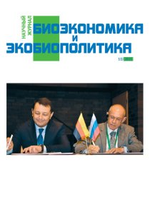The Optimal Ratio of Carbon Dioxide and Nitrogen for Algae Cultivation in Closed Photobioreactors
Авторы: Карякин Д. О., Кулабухов В. Ю.
Рубрика: Тезисы
Опубликовано в Биоэкономика и экобиополитика №1 (1) декабрь 2015 г.
Дата публикации: 30.01.2016
Статья просмотрена: 12 раз
Библиографическое описание:
Карякин, Д. О. The Optimal Ratio of Carbon Dioxide and Nitrogen for Algae Cultivation in Closed Photobioreactors / Д. О. Карякин, В. Ю. Кулабухов. — Текст : непосредственный // Биоэкономика и экобиополитика. — 2015. — № 1 (1). — URL: https://moluch.ru/th/7/archive/20/682/ (дата обращения: 20.04.2024).
Coal incineration is always accompanied by carbon dioxide liberation. А significant decrease of its use in industrial purposes in the near future is not possible, the problem of excessive CO2 concentration and reducing its level in the atmosphere is attracting more attention. For the experiment a closed cultivation system (photobioreactor) was chosen. They have a few technical advantages, are less dependent on environmental parameters. There are several classifications of photobioreactors, for example: tubular, flat panel, column and others. An algae photobioreactor is an effective system for converting carbon dioxide into biomass. The application of algal photobioreactors as absorbing devices is a practical solution of the problem of carbon dioxide emissions, also permitting to cultivate algae biomass. To get the necessary biomass productivity, optimal cultivation conditions should be known. One of them is the presence of carbon dioxide in the layer contacting with the biomass. The purpose of this experiment was to find the optimal carbon dioxide concentration as a proportion amount of carbon dioxide in the gas mixture N2-CO2 for photobioreactor operation.
During this work the investigation of how different CO2 concentrations effect on the cultivation of microalgae was carried. Gas mixing was made in the required volume, carbon dioxide (substrate) was mixed with nitrogen (inert gas). Then the gas was pumped directly into the culture from the intermediate container. All these operations were made through a meter which tracked the gas flow according to preliminary calculations. By controlling the optical algae suspension density the productivity of conditions was determined by the incremental value of biomass. The cultivation has been done in small-size laboratory bioreactors in Tamiya medium.







